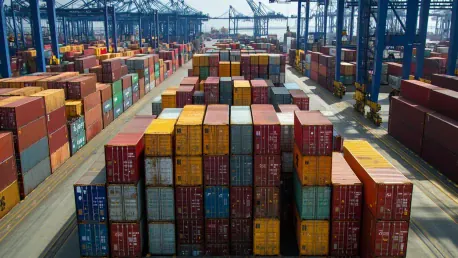The uncertainties arising from ongoing tariff policies have led to a notable surge in cargo volumes at U.S. ports. Driven by the policies of the Trump administration, these changes have significantly impacted the dynamics of port operations across the nation. Retailers, who are key players in the supply chain, have been forced into strategic decision-making to mitigate potential risks associated with escalating tariffs. This trend was particularly pronounced from the beginning of 2025, as variations in trade agreements and tariffs contributed to fluctuating port activities.
Retail Strategies in Response to Tariff Policies
Frontloading Merchandise to Mitigate Risks
Retailers have turned to frontloading merchandise as a strategic response to the uncertainties posed by fluctuating tariff policies. According to the National Retail Federation (NRF) and data from Hackett Associates’ Global Port Tracker, this strategy has been a substantial contributor to the surge in import volumes at U.S. ports. With tariffs on Chinese goods increasing by a considerable 20%, retailers are incentivized to import merchandise in anticipation of future hikes. This tactic allows them to sidestep additional costs that would arise from upcoming tariff implementations.
In January 2025, U.S. port volumes saw a sharp 13.4% increase compared to the same month the previous year. This trend continued into February with a projected 6.1% growth, expected to peak at 10.8% in March. Such consistent growth underscores the retail sector’s proactive measures to cushion the impact of further tariff increases, particularly those scheduled for early April 2025. These steps have ensured that import activities remain buoyant, despite the volatile trade environment. Through strategic frontloading, retailers adeptly navigate supply chain disruptions, underscoring their reliance on timely import management.
Impact of Reciprocal Tariffs on Port Operations
Reciprocal tariffs set to commence on April 2, 2025, have created additional pressures on the retail sector, further driving the urgency to frontload merchandise. These tariffs are projected to affect the cost structure significantly. However, the month-long pause on the 25% tariffs for Canada and Mexico that ended in February 2025 is expected to have minimal impact on overall U.S. port volumes. The majority of trade with Canada and Mexico occurs through truck or rail transportation, buffering maritime trade routes from these specific tariffs.
The U.S. Trade Representative (USTR) has also proposed imposing fees up to $1.5 million on ships built in China. This proposal adds another layer of complexity to the evolving trade landscape. As this policy is currently in the public comment phase, its potential implementation stands to significantly elevate operational costs for cargo owners and consumers. Consequently, it could drive a shift in shipping strategies toward larger vessels to achieve economies of scale and consolidated packages, reducing port activity by smaller vessels. Such shifts would likely place additional pressure on smaller ports, while larger ports could see an uptick in activity due to the logistical adjustments required to handle the consolidated shipments.
Projected Decline and Long-Term Implications
Anticipated Declines in Port Volumes
Despite the surge observed in the early part of 2025, port volumes are projected to decline in the months of June and July 2025. This forecasted downturn signals the first since September 2023 and can be largely attributed to the high levels of frontloading that took place in preceding months. Retailers preemptively increased import volumes in response to concerns over potential labor strikes at East and Gulf Coast ports during fall 2024. This preemptive strategy has led to an anticipated dip in cargo volumes as the initial stockpiles cover retail demands in subsequent months.
The expected decline also reflects a broader market correction following the frontloading activities, with importers having already positioned themselves to withstand tariff hikes. Furthermore, strategic adjustments made in response to tariff provocations would likely reconfigure the supply chain to achieve longer-term stability. Retailers must remain vigilant, continuously reassessing their import strategies in light of the unpredictable trade policies and potential logistical bottlenecks.
Adaptations in Logistics and Supply Chains
The uncertainties stemming from ongoing tariff policies have caused a notable rise in cargo volumes at U.S. ports. Sparked by the Trump administration’s policies, these shifts have had a profound impact on port operations nationwide. Retailers, who play a crucial role in the supply chain, have been compelled to make strategic choices to manage the potential risks associated with rising tariffs. This trend was especially evident from the start of 2025, as changes in trade agreements and tariffs led to unpredictable port activities. With the evolving landscape of international trade, the dynamic responses from retailers and other stakeholders in the supply chain underscore the significant influence of tariff policies on the logistics sector. Adjusting their strategies, these key players have had to remain agile, continually assessing and mitigating the risks posed by fluctuating tariffs and shifting trade agreements, which has, in turn, created a ripple effect throughout the port operations in the United States.








